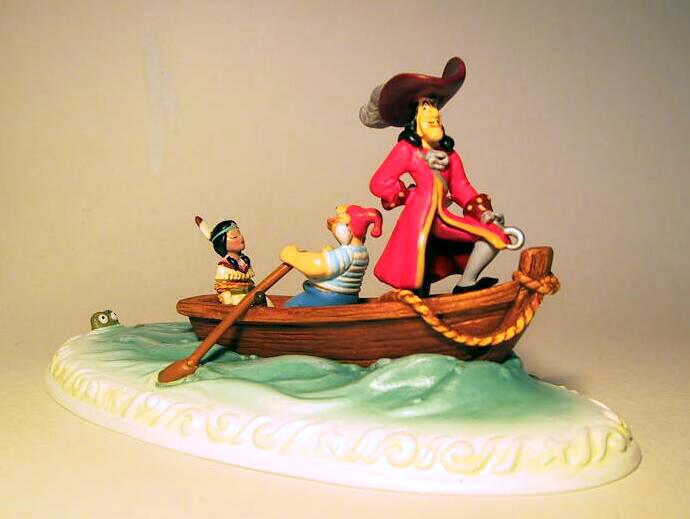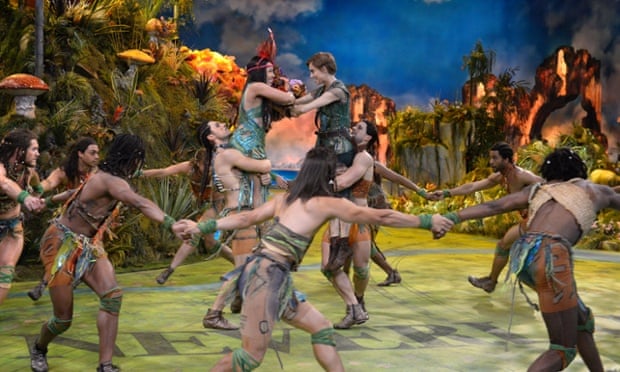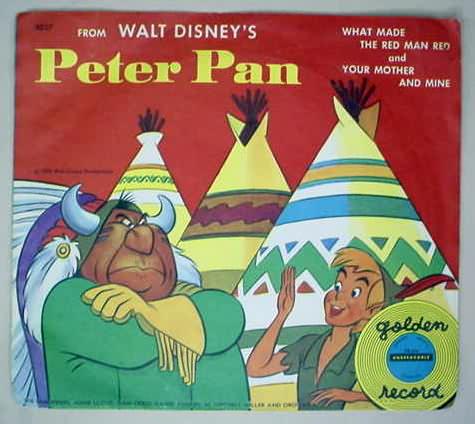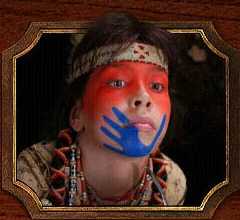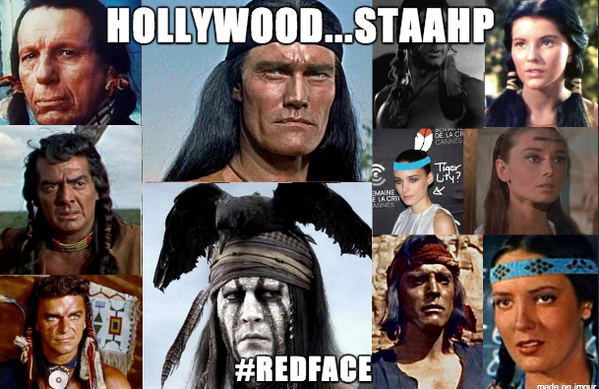While I watched
Peter Pan Live!, I did a bit of live-blogging on Facebook. I didn't plan to debate the production, but a couple of people responded and we were off.
Things started innocuously enough:
Off to Neverland
Watching
Peter Pan Live!--the must-see event of the year!
I have a radical new idea for a remake: Cast a teenage boy to play Peter Pan the teenage boy. You know, instead of a grown woman.
Yes, I'm brilliant, I know. Thank you, thank you.
Didn't Christopher Walken used to sound normal when he was young? Now he sounds like he's doing a Christopher Walken impression.
Casting a teenage boy presents a lot of issues from a musical theater perspective.It can't be much worse than trying to convince oneself that 26-year-old Allison Williams is a teenage boy. I'm not buying it.
I bet Daniel Radcliffe could've nailed it.
Of course, a 25 year old man is much more convincing...it's about the voice, for one, and the ages of the Darling children.I meant when he was a teenager. "Cast a teenage boy [such as Radcliffe when he was a teenager] to play Peter Pan the teenage boy."
Problems arise
Race in #PeterPanLive: Nine of the ten Lost Boys are white. The first four of Tiger Lily's tribe look brown-skinned and ethnic.
Even if the "tribal" actors are white, they're adorned with broad stripes of brown color. This conveys the impression that they're brown.
The tribesmen wear bone chokers and breastplates, and round pendants--like Indians. They tend to creep on all fours--like animals. #PeterPanLive
The Lost Boys, including Michael Darling dressed as an Indian, reject Wendy's attempt to teach them how to avoid war. That's because Lost Boys, like Indian savages, are uncivilized.
As near as I can tell, the Natives are also generic (tribally too unspecific).Yes, they're generic. But making them so doesn't solve the problem, it only redirects it.
The problem is that Peter's Lost Boys are wild, undisciplined, and ignorant because they have no rules, responsibilities, or parents. No law and order. In a word, they're uncivilized. And Tiger Lily's tribesmen are the same.
The message is that Lost Boys = indigenous people = savages. Whether the tribe is from the Americas, Africa, or Asia and the Pacific Islands doesn't really matter. The story is an indictment of
all indigenous cultures. It suggests they're akin to children frolicking in the jungle, or animals in human form.
As someone who grew up with this kind of unfounded, blatant, erroneous picture of Natives, I have only been condemning specific issues in these cases. But I am thrilled that we are finally at a place where we can finally address the broader ignorance issues that needs to be ended. Especially in popular media and entertainment.On the other hand:
For heaven's sakes, it's FANTASY, it's silliness, it's choreographed -- did you notice how realistic the plants and trees were? *not*
Maybe you can go after "Santa Claus is Coming to Town" next time.Are you seriously going to argue that people haven't gotten their ideas about Indians from Western movies, sports mascots, and corporate logos--all of which are forms of fiction? In fact, people absorb messages about reality from whatever they see, including fiction. As a few centuries of novels, plays, movies, TV shows, and comic books have proved.
So we should say nothing about racist stereotypes in movies or TV shows because they're "fantasies"? How about school plays, paintings and statues, or songs? Did you miss the last ten thousand times I criticized racist stereotypes in our culture?
A blackface minstrel show is just a fantasy. As is a Halloween party with Pocahotties and "Nava-hoes." Really, you expect me to give these a pass because they're "fantasies" like
Peter Pan? As the last 20 years of my work has demonstrated, that's not gonna happen.
Lost Boys = Lord of the Flies?Haven't missed a one of your criticisms, and most often agree with them (although I'm protesting your NIGA group for its abominable acronym). I guess you've protested Peter Pan for 30 or more years now?
The Halloween analogy is false -- stupid women wanting to be "Nava-hoes" doesn't compare to Barrie's play, nor the musical. And if you knew the story, you would not put = between Lost Boys and the Indians in the show -- the Lost Boys are a different group altogether.
We've had plenty of literature, that for better or worse, deals with issues like this. Do we ban it all, or do we learn? Would you remove Lord of the Flies from the libraries (after all, they were certainly "Lost Boys" who became quite savage)?The Indian savages perform the same function as the Lost Boys. They run and play in the forest, follow Peter Pan, and fight the pirates. They're different but equivalent groups.
That's why I said the
message is that they're the same. Not that they're literally the same.
I didn't say my examples--the minstrel show and Halloween party--were alike in terms of "quality." But they're all examples of employing fictional or fantasy characters. They're alike in that regard.
And saying my analogy is "false" isn't much of an argument. Explain
why it's false if you can.
In fact, anyone can present a racial stereotype and claim they're just "play-acting" or "pretending." If racism in "fantasy" is harmless, it's harmless whether it's a minstrel show, a Halloween party, or "Peter Pan." I say it's harm
ful in all these cases so the "fantasy" defense is rubbish.
I don't think the
Lord of the Flies boys dressed specifically like Indians. Tiger Lily's tribe did. We're talking about characters who use racial stereotypes to represent a particular group--in this case, Indians or indigenous people. We're not talking about anyone who becomes "savage" in any way.
We're also not talking about censoring or removing
Peter Pan. You invented that straw man because I didn't say a word about it. My solution is to fix the racist and sexist elements of this play and
then present it.
If you want to present the original story with its racism and sexism, go ahead. You do that and I'll criticize it, just as I've done here.
Do we ban it or do we learn from it? I'm
helping people learn from it by educating them about its racism and sexism. You're doing the opposite: telling people to ignore its problems and simply enjoy it as a "fantasy." Don't talk to us about "learning" when you're advocating the opposite.
P.S. My official critique of
Peter Pan is 10 years old:
Tiger Lily in Peter Pan: An Allegory of Anglo-Indian Relations
I found every line about Indians in Barrie's original book to make sure I didn't miss anything. I understand his racist stereotyping well.
No doubt I mentioned the play and the Disney movie before then. And yet Peter Pan is only one of a thousand topics I've dealt with over the years. The facts prove there's no "obsession" here, so your claim is false and insulting.
You say you haven't missed my criticisms, yet you're surprised I criticized
Peter Pan. Criticized it the same way I've criticized countless comic books, cartoons, video games, and other things that qualify as fantasies for children. So why are you surprised?
To reiterate, I've criticized
Peter Pan and movies, TV shows, and plays
like it many times before. My actions have been completely consistent so your surprise is illogical. In fact, the only surprise would be if I
ignored a spectacle featuring Indians in prime-time television.
Racist and sexist, too
On the gender front, #PeterPanLive may be even worse. Girls = mothers = caretakers and servants = nags and scolds = killers of fun and freedom.
Wendy should slap some sense into Peter. "You say you want a mother, but you don't want to do anything I say? What do you think a mother is, you stupid twit?
"If you want someone to serve you, go hire a maid or a butler. I've got better things to do than to babysit babies."
Now she's singing about how she wants to kiss Peter Pan. Even a century ago, girls went for the charming bad boys who would love 'em and leave 'em. All Peter needs is a leather jacket and motorcycle to seal the deal.
Back to the racial issues:
If you want a race of animal-like savages, make them bestial for real. Centaurs, cat people, talking bears, etc. Or make them toy soldiers come to life a la
Toy Story. There's really no excuse to equate savages with indigenous people. #PeterPanLive
Getting a closer look at Tiger Lily's tribe as they dance. Perhaps half the actors are nonwhite. All have dark hair and several have dreadlocks. Shoes look like moccasins. Definitely an Afro-Indian vibe. #PeterPanLive
And they're mixing the Wyandotte song title with "Hickory dickory dock" and "Tweedledee, tweedledum." Well, gee, thanks for making it clear that Native languages aren't just singsong nonsense words.
Not to mention the tom-tom beats and chanting that echo a thousand old Westerns. They aren't even subtle. This is obviously an "Indian" song in everything but name.
And Tiger Lily says Peter is the sun and the moon. Good thing she praised the "great white father" only once in this scene, or it would be unbearable.
Peter is mystified that Wendy, Tinkerbell, and Tiger Lily all want more from him. Why are girls so needy and clingy? Why can't they be strong and independent, like boys?! #PeterPanLive
Do you know when this story was written, what society was like at the time?It was written around the time when Dorothy traveled to Oz, took command of her destiny (more or less), and proceeded without any thought of clinging to a man or becoming a mother.
That was several decades after Alice had her solo adventures in Wonderland. A couple of centuries after Jane Austen's heroines showed what strong, independent women could do. Are you seriously arguing that having all three female characters long for Peter was a sign of the times? That authors like Barrie couldn't conceive of any other way of thinking?
And the producers are putting the play on in 2014, not 1902 when it was written. They're responsible for how its sexist message plays
today. If you or they don't want anyone criticizing the sexism, don't put it on the air
now. Leave it and the racist savages in the dustbin of history where they belong.
Next up: How Santa's message of toys for everyone obscures the structural poverty built into our society.
Tinkerbell must die
Captain Hook's "brilliant" plan to kill Peter Pan is to poison him. He puts the poison in Peter's medicine while he sits next to the sleeping Peter. How about stabbing him in the chest instead? #PeterPanDead
But Tinkerbell drinks it instead! What a bumbler that Hook is!
Tweet to save Tinkerbell? #TinkerbellMustDie
Now Peter is speaking to the audience, telling us to clap if we believe in fairies. Die, you little piece of CGI fakery!!
Odd. The swelling music seems to indicate we should be filled with joy, not laughter at this silliness.
You must have had a very sad childhood -- and I'm not trying to insult. That a grown man is so obsessed with a little musical that children love is worrisome. When I was a little girl, I thought Mary Martin was speaking directly to me. I found joy in the show, and still do. Lovely music, great dancing, lots of fun.As I said, I've posted critiques and analyses of thousands of Native stereotypes. I'm not sure
Peter Pan is even in the top 25 or 50 of the subjects I've covered. Despite the fact that it's one of the longest-running and most prominent purveyors of Native stereotypes in existence.
If you're worried that I spent a couple of hours posting a few comments about one play, I'd hate to see your reaction to the subjects I've actually focused on. You know, things like the Washington Redskins and other mascots,
The Lone Ranger and
Twilight, and hipster headdresses. I guess you'd be amazed at my rock-solid opposition to racist stereotypes wherever they occur.
P.S. My childhood was stunningly normal, not "sad." I'm incredulous that you've suddenly discovered that I criticize things. If you somehow missed my last 10,000 postings, check them again. You'll see a decades-long pattern of denouncing racism, sexism, and other forms of prejudice.
If you don't like that, sorry, but that's what I do. I thought it was obvious, but now you know.
Here are
some of the criticisms directed at this production:
http://nativenewsonline.net/currents/notyourtigerlily-nine-months-later-still-dont-get-point/
https://indiancountrytodaymedianetwork.com/2014/12/05/keene-why-fix-tiger-lily-why-cant-we-just-let-her-go-158155
http://americanindiansinchildrensliterature.blogspot.com/2014/12/true-blood-brothers-in-nbcs-production.html
http://www.salon.com/2014/12/05/the_boggling_mixed_signals_of_peter_pan_live_why_on_earth_did_nbc_decide_to_stage_this_show/
http://www.salon.com/2014/12/06/the_7_worst_things_about_nbcs_peter_pan_live_partner/
I guess a lot of people are "obsessed" or had "sad" childhoods. Which are obvious codewords for, "Stop criticizing my beloved fairy tale, you can't make me think about its racism and sexism, la la la la la I can't hear you!"
A tweet to sum up the racial issues:
Tiger Lily's tribe in #PeterPanLive: brown skins, body paint, bone chokers and breastplates, crawling on all fours--but not stereotypical?!
For more on
Peter Pan, see
Native Stereotypes in Peter Pan Live! and
Peter Pan Live! Reviewed.



